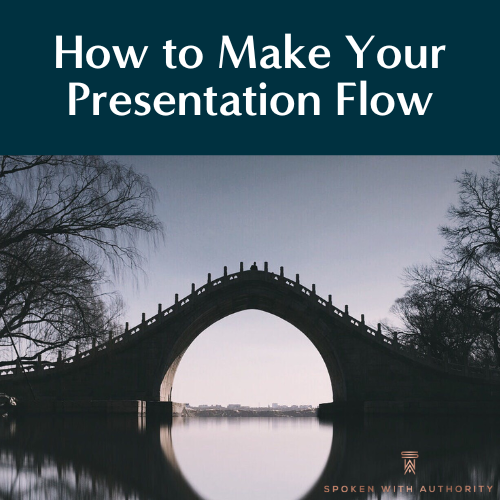How to Make Your Presentation Flow
by Jean Costanza Miller, Ph.D.
Transitions should be a NATURAL bridge—no engineering required.
Have you noticed speakers saying, “With that…” to complete one thought before moving to something new? “With that, we’ll look at future earnings….” “With that, the next step is….” We know we shouldn’t jump from one point to another, and this phrasing is a sign that we haven’t hammered out the relationships among our arguments or the different segments of our presentation.
Notice I said, “arguments” or “segments” of a presentation, NOT SLIDES! Stringing together slides on sub-topics does not count as a coherent or compelling presentation. Slides are supplements, and that is a topic for another day.
Why it matters:
Focusing on how you will transition from one point to the next forces you to think hard about the structure of your presentation and the logical order of your points.
Having strong transitions will make it EASIER for YOU to deliver your presentation. You won’t get stuck not knowing what you want to say next.
Having strong transitions will make it EASIER for YOUR AUDIENCE to follow along and pay attention.
Having your presentation FLOW SEAMLESSLY will elevate your audience’s perception of your credibility.
How to make smooth transition statements:
1. You can’t force a transition to work if your presentation is not clearly organized. Make sure you have a strong narrative arc or organizational structure.
2. Ask yourself how point one relates to point two, how point two relates to point three, and so on. Your narrative arc should help, but you still need to decide on the precise relationship. Does one idea lead logically to the next? Is one argument necessary to understand before the next one can make sense?
3. Consider if a metaphor or analogy will clarify the relationships. Does one idea “build” on another? Are you “moving” through new “terrain”? You can use that language in your transition statements.
4. Make sure your transition statements include a glance back at the previous point and a nod to the next one. You are showing the relationship between them.
What it looks like in practice:
Here’s an example of main points and transitions (the “body” of a presentation, which does not include the opening or closing) for a briefing on a communication strategy:
Point 1: Increasing social media engagement lays the foundation for our overall strategy.
Talk about social media….
Transition: Once this foundation of social media content is in place, earned and paid media become easier and more impactful.
Point 2: Earned and paid media will elevate our profile.
Talk about earned and paid media….
Transition: This strong media profile opens the door to greater policy influence.
Point 3: Policy engagement secures our leadership status.
Talk about policy initiatives….
Notice:
Each transition statement includes a word or phrase that links to the previous main point statement AND the succeeding main point statement.
The transition statements add helpful repetition. These statements are not redundant. Instead, they reinforce your core message.
You don’t have to use the word “this” in your transition statements, but including it is a good way to ensure you are glancing back at the previous point. Remember, “this” should be followed by a noun.
The devil is in the details. A little extra effort to ensure smooth transitions through your presentation will pay off. Try it out, and let us know how it goes!

